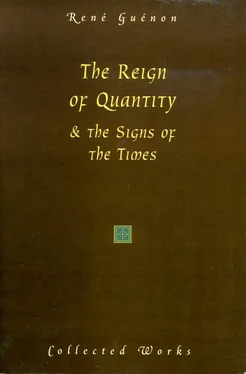A ‘satanic’ character is revealed with particular clarity in the psychoanalytic interpretations of symbolism, or of what is held rightly or wrongly to be symbolism, this last proviso being inserted because on this point as on many others, if the details were gone into, there would be many distinctions to make and many confusions to dissipate: thus, to take only one typical example, a vision in which is expressed some ‘supra-human’ inspiration is truly symbolic, whereas an ordinary dream is not so, whatever the outward appearances may be. Psychologists of earlier schools had of course themselves often tried to explain symbolism in their own way and to bring it within the range of their own conceptions; in any such case, if symbolism is really in question at all, explanations in terms of purely human elements fail to recognize anything that is essential, as indeed they do whenever affairs of a traditional order are concerned; if on the other hand human affairs alone are really in question, then it must be a case of false symbolism, but then the very fact of calling it by that name reveals once more the same mistake about the nature of true symbolism. This applies equally to the matters to which the psychoanalysts devote their attention, but with the difference that in their case the things to be taken into consideration are not simply human, but also to a great extent ‘infra-human’; it is then that we come into the presence, not only of a debasement, but of a complete subversion; and every subversion, even if it only arises, at least in the first place, from incomprehension and ignorance (than which nothing is better adapted for exploitation to such ends), is always inherently ‘satanic’ in the true sense of the word. Besides this, the generally ignoble and repulsive character of psychoanalytical interpretations is an entirely reliable ‘mark’ in this connection; and it is particularly significant from our point of view, as has been shown elsewhere, [140] See The Spiritist Fallacy , pt. 2, chap. 10.
that this very same ‘mark’ appears again in certain spiritualist manifestations — anyone who sees in this no more than a mere ‘coincidence’ must surely have much good will, if indeed he is not completely blind. In most cases the psychoanalysts may well be quite as unconscious as are the spiritualists of what is really involved in these matters; but the former no less than the latter appear to be ‘guided’ by a subversive will making use in each case of elements that are of the same order, if not precisely identical. This subversive will, whatever may be the beings in which it is incarnated, is certainly conscious enough, at least in those beings, and it is related to intentions that are doubtless very different from any that can be suspected by people who are only the unconscious instruments whereby those intentions are translated into action.
Under such conditions, it is all too clear that resort to psychoanalysis for purposes of therapy, this being the usual reason for its employment, cannot but be extremely dangerous for those who undergo it, and even to those who apply it, for they are concerned with things that can never be handled with impunity; it would not be taking an exaggerated view to see in this one of the means specially brought into play in order to increase to the greatest possible extent the disequilibrium of the modern world and to lead it on toward final dissolution. [141] Another example of such means is furnished by the comparable employment of ‘radiaesthesia’, for in this case also psychic elements of the same quality very often come into play, though it must be admitted that they do not appear under the ‘hideous’ aspect that is so conspicuous in psychoanalysis.
Those who practice such methods are on the other hand without doubt convinced of the benefits afforded by the results they obtain; theirs is however the very delusion that makes the diffusion of these methods possible, and it marks the real difference subsisting between the intentions of the ‘practitioners’ and the intentions of the will that presides over the work in which the practitioners only collaborate blindly. In fact, the only effect of psychoanalysis must be to bring to the surface, by making it fully conscious, the whole content of those lower depths of the being that can properly be called the ‘sub-conscious’; moreover, the individual concerned is already psychologically weak by hypothesis, for if he were otherwise he would experience no need to resort to treatment of this description; he is by so much the less able to resist ‘subversion’, and he is in grave danger of foundering irremediably in the chaos of dark forces thus imprudently let loose; even if he manages in spite of everything to escape, he will at least retain throughout the rest of his life an imprint like an ineradicable ‘stain’ within himself.
Someone may raise an objection here, based on a supposed analogy with the ‘descent into hell’ as is met with in the preliminary phases of the initiatic journey; but any such assimilation is completely false, for the two aims have nothing in common, nor have the conditions of the ‘subject’ in the two cases; there can be no question of anything other than a profane parody, and that idea alone is enough to impart to the whole affair a somewhat disturbing suggestion of ‘counterfeit’. The truth is that this supposed ‘descent into hell’, which is not followed by any ‘re-ascent’, is quite simply a ‘fall into the mire’, as it is called according to the symbolism of some of the ancient Mysteries. It is known that this ‘mire’ was figuratively represented as the road leading to Eleusis, and that those who fell into it were profane people who claimed initiation without being qualified to receive it, and so were only the victims of their own imprudence. It may be mentioned that such ‘mires’ really exist in the macrocosmic as well as in the microcosmic order; this is directly connected with the question of the ‘outer darkness’, [142] The reader may be referred here to what has been said earlier about the symbolism of the ‘Great Wall’ and of the mountain Lokāloka .
and certain relevant Gospel texts could be recalled, the meaning of which agrees exactly with what has just been explained. In the ‘descent into hell’ the being finally exhausts certain inferior possibilities in order to be able to rise thereafter to superior states; in the ‘fall into the mire’ on the other hand, the inferior possibilities take possession of him, dominate him, and end by submerging him completely.
There was occasion in the previous paragraph again to use the word ‘counterfeit’; the impression it conveys is greatly strengthened by some other considerations, such as the denaturing of symbolism previously mentioned, and the same kind of denaturing tends to spread to everything that contains any element of a ‘supra-human’ order, as is shown by the attitude adopted toward religion, [143] Freud devoted a book specially to the psychoanalytical interpretation of religion, in which his own conceptions are combined with the ‘totemism’ of the ‘sociological school’.
and toward doctrines of a metaphysical and initiatic order such as Yoga . Even these last do not escape this new kind of interpretation, which is carried to such a point that some proceed to assimilate the methods of spiritual ‘realization’ to the therapeutical procedures of psychoanalysis. This is something even worse than the cruder deformations also current in the West, such as those in which the methods of Yoga are seen as a sort of ‘physical culture’ or as therapeutic methods of a purely physiological kind, for their very crudity makes such deformations less dangerous than those that appear in a more subtle guise. The subtler kind are the more dangerous not simply because they are liable to lead astray minds on which the less subtle could obtain no hold; they are certainly dangerous for that reason, but there is another reason affecting a much wider field, identical with that which has been described as making the materialistic conception less dangerous than conceptions involving recourse to an inferior psychism. Of course the purely spiritual aim, which alone constitutes the essentiality of Yoga as such, and without which the very use of the word becomes a mere absurdity, is no less completely unrecognized in the one case than in the other. Yoga is in fact no more a kind of psychic therapy than it is a kind of physiological therapy, and its methods are in no way and in no degree a treatment for people who are in any way ill or unbalanced; very far from that, they are on the contrary intended exclusively for those who must from the start and in their own natural dispositions be as perfectly balanced as possible if they are to realize the spiritual development which is the only object of the methods; but all these matters, as will readily be understood, are strictly linked up with the whole question of initiatic qualification. [144] On an attempt to apply psychoanalytical theories to the Taoist doctrine, which is of the same order as Yoga , see the study by André Préau, La Fleur d’or et le Taoïsme sans Tao [Paris: Bibliothèque Chacornac, 1931], which contains an excellent refutation of the attempted application.
Читать дальше











